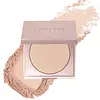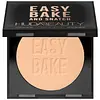Lawless Skin-Smoothing Talc-Free Perfecting Powder Versus Huda Beauty Easy Bake & Snatch Pressed Brightening & Setting Powder
What's inside
What's inside
 Key Ingredients
Key Ingredients

 Benefits
Benefits

 Concerns
Concerns

 Ingredients Side-by-side
Ingredients Side-by-side

Synthetic Fluorphlogopite
Zinc Stearate
Cosmetic ColorantSqualane
EmollientPerlite
AbsorbentCaprylyl Glycol
EmollientEthylhexylglycerin
Skin ConditioningButyl Avocadate
Skin ConditioningBisabolol
MaskingHelianthus Annuus Seed Oil
EmollientGlycerin
HumectantWater
Skin ConditioningTocopherol
AntioxidantLycium Barbarum Fruit Extract
AstringentNasturtium Officinale Extract
PerfumingTropaeolum Majus Extract
AntimicrobialSorbic Acid
PreservativeCI 77891
Cosmetic ColorantIron Oxides
CI 19140
Cosmetic ColorantCI 77163
Cosmetic ColorantCI 77742
Cosmetic ColorantMica
Cosmetic ColorantSynthetic Fluorphlogopite, Zinc Stearate, Squalane, Perlite, Caprylyl Glycol, Ethylhexylglycerin, Butyl Avocadate, Bisabolol, Helianthus Annuus Seed Oil, Glycerin, Water, Tocopherol, Lycium Barbarum Fruit Extract, Nasturtium Officinale Extract, Tropaeolum Majus Extract, Sorbic Acid, CI 77891, Iron Oxides, CI 19140, CI 77163, CI 77742, Mica
Mica
Cosmetic ColorantBoron Nitride
AbsorbentNylon-12
Magnesium Myristate
Caprylic/Capric Triglyceride
MaskingButyl Avocadate
Skin ConditioningOlea Europaea Fruit Oil
MaskingHyaluronic Acid
HumectantTocopherol
AntioxidantRicinus Communis Seed Oil
MaskingPhenoxyethanol
PreservativeDimer Dilinoleyl Dimer Dilinoleate
EmollientOctyldodecyl Stearoyl Stearate
EmollientSodium Dehydroacetate
PreservativeCI 19140
Cosmetic ColorantIron Oxides
Mica, Boron Nitride, Nylon-12, Magnesium Myristate, Caprylic/Capric Triglyceride, Butyl Avocadate, Olea Europaea Fruit Oil, Hyaluronic Acid, Tocopherol, Ricinus Communis Seed Oil, Phenoxyethanol, Dimer Dilinoleyl Dimer Dilinoleate, Octyldodecyl Stearoyl Stearate, Sodium Dehydroacetate, CI 19140, Iron Oxides
Ingredients Explained
These ingredients are found in both products.
Ingredients higher up in an ingredient list are typically present in a larger amount.
Butyl Avocadate isn't fungal acne safe.
CI 19140 is also known as Tartrazine. Tartrazine is a synthetic dye used in cosmetics, foods, and medicine to add a yellow color.
Tartrazine is created from petroleum and is water-soluble.
Some people may experience allergies from this dye, especially asthmatics and those with an aspirin intolerance.
Learn more about CI 19140Mica is a naturally occurring mineral used to add shimmer and color in cosmetics. It can also help improve the texture of a product or give it an opaque, white/silver color.
Serecite is the name for very fine but ragged grains of mica.
This ingredient is often coated with metal oxides like titanium dioxide. Trace amounts of heavy metals may be found in mica, but these metals are not harmful in our personal products.
Mica has been used since prehistoric times throughout the world. Ancient Egyptian, Indian, Greek, Roman, Aztec, and Chinese civilizations have used mica.
Learn more about MicaTocopherol (also known as Vitamin E) is a common antioxidant used to help protect the skin from free-radicals and strengthen the skin barrier. It's also fat soluble - this means our skin is great at absorbing it.
Vitamin E also helps keep your natural skin lipids healthy. Your lipid skin barrier naturally consists of lipids, ceramides, and fatty acids. Vitamin E offers extra protection for your skin’s lipid barrier, keeping your skin healthy and nourished.
Another benefit is a bit of UV protection. Vitamin E helps reduce the damage caused by UVB rays. (It should not replace your sunscreen). Combining it with Vitamin C can decrease sunburned cells and hyperpigmentation after UV exposure.
You might have noticed Vitamin E + C often paired together. This is because it is great at stabilizing Vitamin C. Using the two together helps increase the effectiveness of both ingredients.
There are often claims that Vitamin E can reduce/prevent scarring, but these claims haven't been confirmed by scientific research.
Learn more about TocopherolThis ingredient is a combination of red, black, and yellow iron oxide pigments. This combination of colors is usually found in foundation, because it results in a "skin" color.